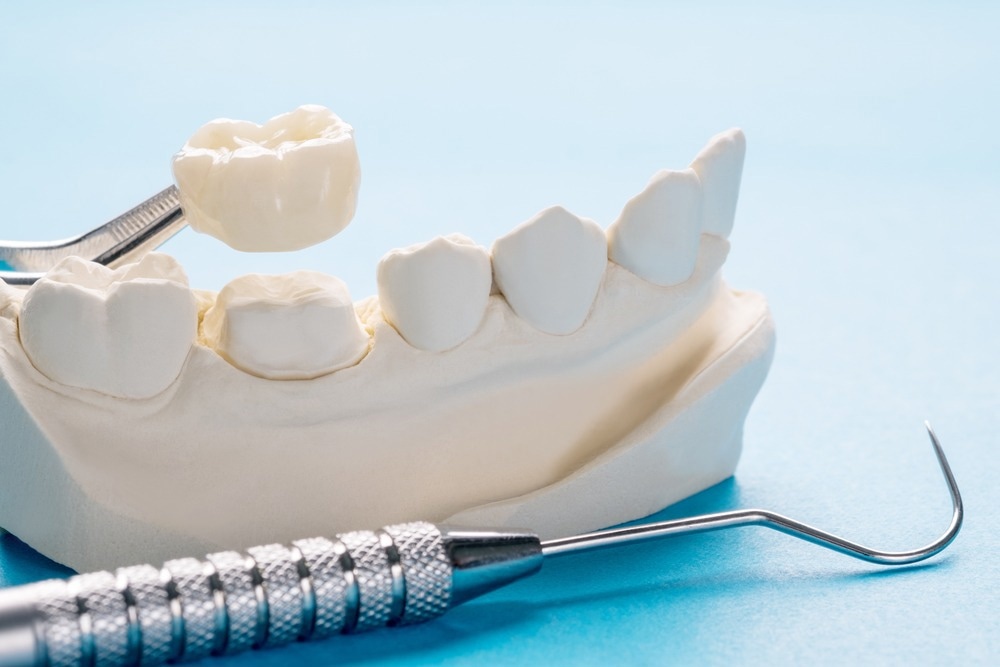Sharpey’s fiber is a connective tissue composed of a collagen matrix that connects the tooth with the alveolar bone. Due to its micronanofiber architecture, distinct location, and vertical alignment corresponding to the tooth surface, Sharpey's fiber plays a crucial role in endowing a healthy tooth with facile differentiation ability, mechanical stability, and disease protection.

Study: Bioinspired Collagen/Gelatin Nanopillared Films as a Potential Implant Coating Material. Image Credit: sujit kantakat/Shutterstock.com
Inspired by the natural architecture of Sharpey's fiber, a study published in ACS Applied Bio Materials presented the preparation of a gelatin (col:gel) biopolymeric film with nanopillars that could be used as a dental implant coating with enhanced cellular and osteogenic properties. These biopolymeric films were prepared using nanoporous anodic aluminum oxide molds (AAOM) via drop casting.
Scanning electron microscopy (SEM) and atomic force microscopy (AFM) images revealed nanopillars with 90 nanometers diameter, 300 nanometers height, and interpillar space of 50 nanometers that were well-organized on the underlying biopolymer films.
As the nanopillars are parallelly aligned with each other and perpendicular to the biopolymeric film, they mimicked Sharpey’s fibers, which are natural collagenous structures in terms of their geometrical orientation, nanoscale morphology, and biochemical content.
Furthermore, the col:gel films with nanopillars showed over 90% cell viability with improved attachment and mineralization for Saos-2 cells compared to tissue culture polystyrene (TCPS) controls or flat col:gel films because of their enhanced surface roughness and area.
Osseointegration and Sharpey's Fibers
The long-term effectiveness of dental implants, which replace missing teeth, depends on osseointegration and tight soft-tissue integration. Poor implant integration with the soft tissue or bone can result in delayed wound healing due to implant separation or local infection.
Researchers have focused on improving osseointegration using several methods, including surface chemical and physical alterations, as well as coatings based on polymers and ceramic biomaterials.
A biomimetic polymeric material-based implant coating on the tooth’s surface is one such material that can encourage the development of an environment-like extracellular matrix (ECM), for improving cellular adhesion and other biological processes of cells.
Collagen is the predominant component of the ECM of all oral tissues that interact with dental implants. It is responsible for the mechanical improvement, cellular attachment, and ECM mineralization. Additionally, it controls immunogenicity and bone hemostasis primarily because of its hydrophilicity and RGD (arginine, glycine, aspartic acid)-rich composition.
Collagen-based Sharpey's fibers have micro/nanoscale diameters and are located between the alveolar bone and the tooth. They provide a mechanical and physiological bridge between the alveolar bone and cementum, owing to their distinct locations. In addition, Sharpey's fibers also offer cells a supportive ECM environment. Sharpey's fibers are also partly or entirely mineralized, with one end in the bone and the other in the cement.
Sharpey’s fibers were vertically aligned, which is necessary to form a secure link to protect bone tissue from external stimuli and to enclose soft tissue. These fibers link the periodontal ligament, cementum, and alveolar bone, suggesting a perpendicular orientation corresponding to the tooth surface, while the fibers are arranged parallel to each other.
Sharpey’s Fiber-Mimetic Col:Gel Films With Nanopillars
Previously, chitosan-based films with well-organized nanopillars were found to have great antibacterial qualities as well as promoted osteoblastic differentiation pathways with outstanding mineralization capabilities. Moreover, nanostructured films mimicked the architecture of the natural ECM components more closely than flat films.
In the present study, biopolymeric material that was bioinspired from the composition and geometrical nanoarchitecture of Sharpey’s fibers was prepared for its potential use as an implant coating surface to enhance the cell’s adhesion and development for the process of osseointegration.
The biopolymeric films were fabricated with vertically aligned collagen and gelatin-based nanopillars. Here, gelatin served as a filler to reinforce the collagen matrix and fill the gaps between nanopillars to improve the processability of the film. The gelatin and collagen were cross-linked by poly(ethylene glycol) diglycidyl ether (PEGDE).
Since gelatin is a denaturation product of collagen, it has all the physical and biological properties of collagen. Moreover, its water solubility and nonallergenic properties make gelatin more advantageous than collagen.
The cell cultures studies on Saos-2 cells, using flat col:gel films and TCPS as controls, revealed that the prepared nanopillars decorated col:gel films showed enhanced osseointegration and served as a material for implant coating.
Conclusion
In summary, the drop-casting method was used to create col:gel films containing nanopillars which were bio-inspired by Sharpey's fibers. The col:gel films prepared using AAOM had many consistent and well-organized nanopillars.
The research findings showed that, compared to flat films and TCPS controls, col:gel films containing nanopillars had enhanced surface roughness, and surface area values boosted the adhesion and osteogenic differentiation of Saos-2 cells. Sharpey’s fiber-mimicking gel film-based nanopillars could impart enhanced osseointegration as a potential material for dental implant coatings.
Reference
Erturk, P.A., Altuntas, S., Irmak, G., Buyukserin, F. (2022). Bioinspired Collagen/Gelatin Nanopillared Films as a Potential Implant Coating Material. ACS Applied Bio Materials. https://pubs.acs.org/doi/10.1021/acsabm.2c00633
Disclaimer: The views expressed here are those of the author expressed in their private capacity and do not necessarily represent the views of AZoM.com Limited T/A AZoNetwork the owner and operator of this website. This disclaimer forms part of the Terms and conditions of use of this website.